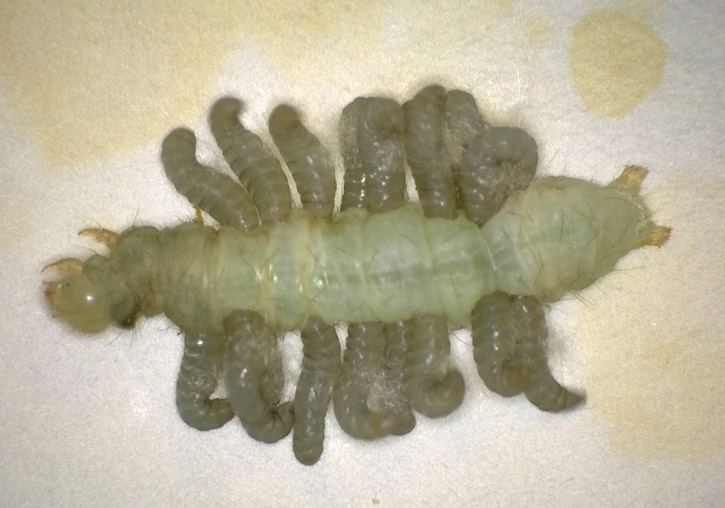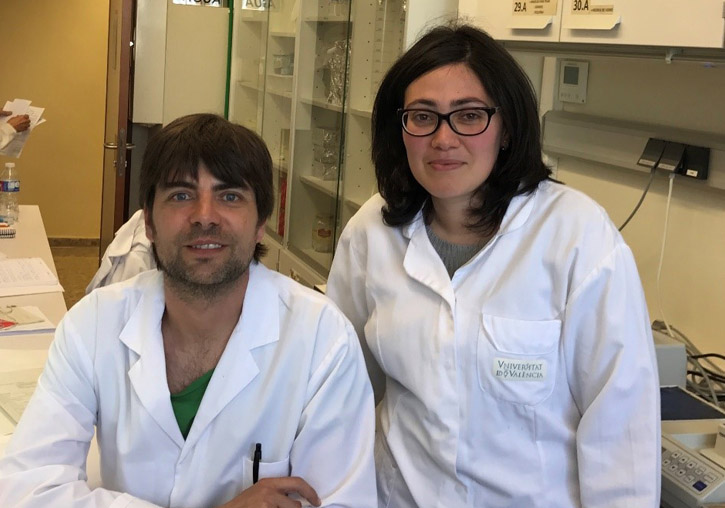
Salvador Herrero, a researcher at the Department of Genetics of the University of Valencia (UV), and Laila Gasmi, a doctorate at the institution, in collaboration with research groups from Japan, Canada and South Korea, have discovered a new family of genes present in most insect-infecting DNA viruses, which have integrated multiple times into the genomes of their host and have given them protection against certain groups of parasitoid wasps. The work was published Friday in the journal Science.
Parasitoid wasps, to reproduce, lay their eggs inside the host insects, where their young will develop, and cause the death of the host insect at the end of the cycle. Different species of parasitoid wasps are used as biological control agents, since they allow, through parasitism, to control certain pest insects without the need for the use of chemical insecticides. To date, the reason why certain parasitoid wasps were unable to develop in certain species of insects was unknown. With this work, a new family of genes has been identified, called parasitoid killing factor, the product of which is lethal to a group of parasitoids.
An important aspect of this finding, according to Laila Gasmi, first author of the work, is that this family of genes is present in several groups of DNA viruses that infect insects. In the case of viruses, “we have discovered that these genes serve to compete with parasitoids for the same host. That is, in those cases where the insect is simultaneously parasitised and infected by the virus, the activity of this new protein is toxic for the parasitoid and the virus can completely dispose of the host”, according to Gasmi. On other occasions, it is the parasitoids that, when they inject their eggs into the host, take advantage to infect it with a virus that has these genes but is not toxic for that parasite, but for others that could also parasitise the same host.
“What does not kill you makes you stronger”, Professor Salva Herrero explains what happened throughout evolution with this family of genes. “The most surprising thing about these genes is that we have detected that they have been transferred on multiple occasions to the genome of some species of Lepidoptera (moths and butterflies). Apparently throughout evolution, some insects that survived infection with a virus carrying these genes, and through a process of horizontal gene transfer between the virus and the insect, incorporated it into their genome. The presence of these genes conferred protection against parasitisation and therefore this characteristic was selected generation after generation.”
Herrero points out that these results, which are published today in the prestigious journal Science, are relevant since, in addition to adding new elements unknown to date to the immune system of insects, they show the complexity of the evolutionary process behind the competition between a parasite and its guest. This study reveals how viruses also play an important role in such competition for the survival of the best fit.
“From an applied point of view, taking into account that some species of parasitoid wasps are used efficiently in agriculture to control insect pests, understanding those factors that determine why some insects are more or less susceptible to different parasites and other natural control agents such as viruses and entomopathogenic bacteria will help us to be more efficient in controlling pests through the use of natural enemies”, explains Herrero. With this measure, the use of control agents that are more harmful to health and less respectful with the environment will be reduced.
Pest control research
Salvador Herrero is associate professor in the Department of Genetics of the UV and a researcher in the Biotechnological Control of Agricultural Pests group of the University Institute of Biotechnology and Biomedicine, of the same academic institution. The research in his team focuses on the study of the molecular mechanisms that regulate the interaction between insects and their viral and bacterial pathogens to promote a rational control of agricultural pests. Herrero has developed his career in laboratories in the Netherlands, Australia and Israel and has participated in numerous projects, both national and international, related to the use of pathogens in the control of pests with insects.
Laila Gasmi completed her doctoral studies at the University of Valencia. After a postdoctoral period at the Tokyo University of Agriculture and Technology that allowed her to complete this study started at the University of Valencia, she moved to the National University of Jeonbuk (South Korea). Currently, she works at the University of Pavia (Italy) where she studies new genes acquired by the tiger mosquito as markers of its immunity against RNA viruses.
Annex photo caption:
Salva Herrero and Laila Gasmi in their laboratory at the University of Valencia.
Video:
https://ir.uv.es/N19B1Ol. It describes the process of parasitism. Once the eggs are injected into the caterpillar, they develop inside the host and when they reach their last stage, they emerge to form the pupae that will give rise to a new generation of wasps. Video: Vanessae5. Courtesy of Dr. Vincent Hervet, AAFC Morden Research and Development Centre and Patrick R. Barks, University of Lethbridge.
Article: Gasmi, L. et al. 2021. «Horizontally transmitted parasitoid killing factor shapes insect defense to parasitoids». Science. Link: https://science.sciencemag.org/cgi/doi/10.1126/science.abb6396
Images:














